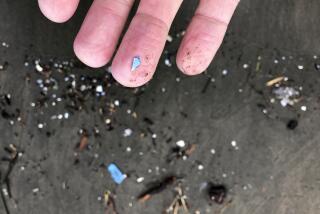Microplastic in the atmosphere is making its way to the pristine Arctic
Scientists who sampled seemingly pristine Arctic snow have discovered high levels of microplastics that were likely carried north by the atmosphere.
The discovery, published in the journal Science Advances, points to an unexpectedly high source of microplastics in one of the most remote and pristine regions of Earth. It also raises troubling questions about the environmental and health implications of potential exposure to such airborne plastics.
“I was really astonished concerning the high concentrations,” said senior author Gunnar Gerdts, a marine microbiologist at the Alfred Wegener Institute in Germany.
Some 380 million metric tons of plastic are produced each year. Much of that plastic ends up in the trash — in fact, experts predict that by 2050, the world will be throwing away 3.4 billion metric tons of the stuff each year, the study authors wrote.
The problem is that plastic is highly durable, which means it doesn’t easily degrade once it’s tossed into a landfill. But it can be broken up into smaller and smaller pieces until it becomes microplastic, fragments that are smaller than 5 millimeters in size.
Many countries let waste leak into the environment, and that plastic and microplastic can last for a long time — and travel a long way.
Discarded plastics have washed up on the shores of remote islands. They’ve collected in the open ocean, forming polluted regions such as the Great Pacific Garbage Patch. And according to previous work by Gerdts and his colleagues, they’ve even ended up in the Arctic, a region that should be largely untouched by human activity.
“We found a lot of microplastics, like record concentrations, and the question arose: From where does the microplastic originate?” Gerdts said. There were only two likely suspects: “It’s from the water or from the air.”
A large amount of plastic gets moved around on ocean currents, but researchers have begun to show that it can be circulated in the air as well. Scientists have found microplastics in the atmospheric fallout of cities like Tehran, Iran and Dongguan, China. Another study in France found that the concentration of microplastic deposited from the atmosphere spiked fivefold after it rained, suggesting that precipitation may play some role in its movements.
To find out how much microplastic was in the air, Gerdts and his colleagues analyzed snow collected from ice floes drifting in Fram Strait east of Greenland and from the nearby Norwegian archipelago of Svalbard. They also gathered samples around cities in Europe and from the Alps so they could compare the different environments.
The samples took many routes to get to the research lab. Scientists flew by helicopter or sailed by dinghy to ice floes in the Fram Strait to scoop snow with a clean mug and a steel spoon or soup ladle. Citizen scientists on snowmobiles gathered samples in Svalbard. Team members in Bremen, Germany, used glass jars to carefully collect fresh powder from white-coated cars.
The scientists were careful to sample only snow on the surface because they wanted to see how much microplastic was brought there by fresh precipitation. Snow can pick up tiny particles and pollutants and transport them over great distances, and the researchers wanted to know if they were doing the same for microplastics, too.
The scientists then used a type of infrared spectroscopy to determine the composition of their samples.
The team found up to 14,400 microplastic particles per liter of melted Arctic snow. That was not as high as the European samples, which contained up to 154,000 particles per liter, but it was still unexpectedly high for a region that is supposed to be all but beyond the influence of humans, the researchers said.
Among the particles the researchers detected were varnish, different types of rubber, polyethylene (the kind of plastic in grocery bags) and polyamide (a component of materials like nylon and Kevlar). Some samples had only a couple different types of polymer; others had a dozen.
There were also compositional differences in different locations. The Arctic samples held mostly nitrile rubber, acrylics and paint. Snow from near a rural road in Bavaria had several types of rubber, some of which are often found in car tires, among other things.
The particles were very small, ranging in size from 475 microns (less than half a millimeter) to just 11 microns. A full 80% of those particles measured 25 microns or less. And as the particles got smaller, they generally became more numerous. This hints that there may be many more particles even smaller than the scientists’ 11-micron detection limit.
Plastic and microplastics have been thought of as marine and aquatic pollutants, ending up in waterways, oceans and the animals that live within them. But the airborne particles found in this study add to a growing body of evidence suggesting that microplastics could be contributing to air pollution — and thus could be impacting the health of terrestrial life on Earth, including humans.
Of course, the microplastics that end up in the Arctic don’t simply disappear, said Chelsea Rochman, an ecologist at the University of Toronto who was not involved in the study.
“The Arctic is an incredibly fragile ecosystem that is under a lot of stress,” she said. “With climate change, where you have ice melting, you might have more plastics being bio-available than you did when it’s locked up in the ice.”
This means the plastic could be finding its way into food chains that include Inuit communities, Rochman said. Some of the people she works with are already concerned that their food sources have been contaminated.
Beyond examining conditions in the Arctic, the new findings offer a more global perspective on what might be called a “plastic cycle,” she added.
“Microplastics are everywhere and ubiquitous and they’re cycling in the water cycle, and we should think about this more broadly,” she said.
More research is needed to evaluate the full environmental and health impacts of airborne microplastics, the study said.
“I think we have to have a holistic view on the microplastics problem,” Gerdts said. “It’s a global problem — and if we want to understand the sources and the sink, we really have to team up with other disciplines, other scientists, to get a full picture and finally to judge whether it’s really dangerous or not.”







